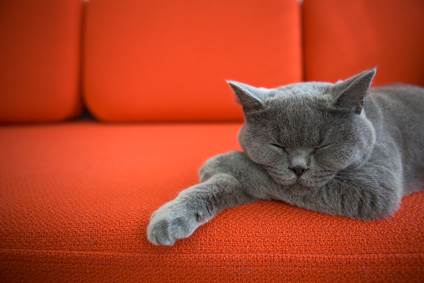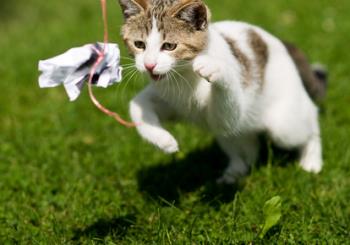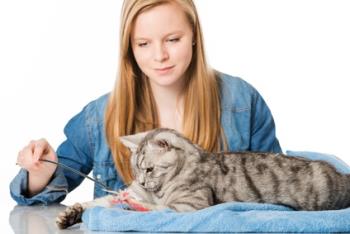Playing with your cat provides numerous benefits; it fights obesity, limits boredom, and solves cat behavior problems. Besides, many cat owners claim that playing with their cats is fun—if the cat plays along, that is.

Unfortunately, not all cats are equally enthusiastic about playing. Some cats love to follow toys with their gaze but never jump on them. Some do play, but only on Tuesdays, while others do not really seem to care at all. In this article, you will learn how to get a lazy cat to play with toys.
- How do you play with your cat? Or do you play? Solo play toys are a great addition to your cat’s play routine, but the real benefit lies in toys that are controlled by you (think of toys like a bird on a string, mouse on a wire, or feather on a stick). Unlike fake mice that just sit still, these are controlled by an intelligent being (that’s you, and we’re not saying that cats are not smart) with varying speeds, directions, and movements that play off of your cat’s actions. No robotic toy can do that (yet). In our experience, cats who play with their owners are also more willing to engage in solo play at other times.
- Try different toys and rotate them. No two cats are alike. Different cats have different preferences. Try several toys to get a glimpse of what sparks your cat’s interest and what doesn’t. A larger variety of toys, both interactive and solo, means that you can rotate them to keep them new and exciting.
- Copy the hunting process. The reason why many cats are extremely excited about playing is that they are genetically predisposed to jump after mouse-sized objects moving away from them. This is a beneficial trait for your cat’s wild counterparts, and you can exploit it to get your lazy cat off the couch. Try to move the toy like a real prey animal would move in the wild (that is, with varying speed but not dangling like a neurotic supermouse; try moving it away from and then toward your cat, but not as if it’s suicidally jumping in his face). Toys can also make sounds. No, don’t do the squeaking yourself, but tap or scratch the toy on the floor.
- Add objects into the playground. As you play with your cats, you’ll see a huge difference in their interest when playtime occurs on an empty floor or when a box, for example, is placed out in the middle. The box provides some much-needed variation. You move the toy around the box, your cat follows it. You move the toy on top of it, your cat jumps to chase it. Your cat’s curiosity is never allowed to rest. If a cat follows a toy with his gaze and it disappears around a corner, he must follow it to keep it in sight. Again, this comes from your cat’s natural hunting behavior. In addition to boxes, you can use furniture, cat trees, and even yourself if you stand in between the cat and the toy to block your cat’s view.
 Allow your cat to catch the toy. Once in a while, since play mimics hunting, your cat should also get a little taste of victory. Let your cat pounce on the toy, hold it under his paws, and chew it. Try to pull the toy lightly, as if the mouse is weakly struggling for its life (it sounds mean, but it’s just a toy) and you’ll see how your cat tightens his grasp. At some point, he will release the toy, and you can use this moment to reclaim ownership and start all over again.
Allow your cat to catch the toy. Once in a while, since play mimics hunting, your cat should also get a little taste of victory. Let your cat pounce on the toy, hold it under his paws, and chew it. Try to pull the toy lightly, as if the mouse is weakly struggling for its life (it sounds mean, but it’s just a toy) and you’ll see how your cat tightens his grasp. At some point, he will release the toy, and you can use this moment to reclaim ownership and start all over again.- Know the timing. Not all moments are equally ideal for playtime. Remember, it is natural for cats to sleep a lot, and if they do, it’s not because they are lazy. The rhythm of a wild cat follows a specific pattern, which includes napping, hunting, eating, and cleaning, and then napping, hunting…. Do you see where playing belongs in there? Cats are most alert after naps and before meals. Naturally, then, cats tend to get sleepy after eating, so that’s not a good time to beg for their attention. This means that it’s best to feed your cat at specific meal times. If you get used to playing with your cat (and feeding him) at approximately the same time each day, he will catch on to the rhythm and will start to anticipate the play.
- Play short. Short play sessions help both of you to focus better. Cats are animals with a naturally short attention span. It’s not like that’s a bad thing—you just have to keep that in mind. Unlike dogs, cats don’t track their prey for hours and won’t chase it for miles. Apply that knowledge to playing and you’ll see that play sessions as short as five minutes are completely fine for cats. Play works best if repeated several times during the day. Initially, you can play for as long as you can hold your cat’s attention, which can be anything from going after the toy to simply taking a quick glance at it. Don’t be pushy; if you reward your cat with a treat after any action that can be described as “playing” or “almost playing,” he will start to look forward to playtime and his ability to stay focused will increase.
 Play alone. Some cats avoid playtime because they feel insecure and shy, not because they are lazy. This is very common in multi-cat households, where even if the shy cat musters up the courage and curiosity to play, he is bumped away by the more adventurous cat. We see this in our own home, and we have solved it by taking our shyest cat (Bella) into a separate room behind closed doors. The distraction-free environment lets her open up and play, which increases her confidence.
Play alone. Some cats avoid playtime because they feel insecure and shy, not because they are lazy. This is very common in multi-cat households, where even if the shy cat musters up the courage and curiosity to play, he is bumped away by the more adventurous cat. We see this in our own home, and we have solved it by taking our shyest cat (Bella) into a separate room behind closed doors. The distraction-free environment lets her open up and play, which increases her confidence.- Use food dispenser toys. When all else fails, you can entice your cat to play by using a toy that rewards your cat for playing with it. The most common option is a treat ball, a ball that drops out pieces of food one by one as long as your cat keeps playing with it. If your cat loves food (and most cats do), it simply can’t fail, because the treat ball is consistent. Play equals food, and no play equals no food. Just as for cats in the wild, no hunting equals no food. You can feed one, a few, or all meals to your cat this way, and even if he won’t play with other toys, he’ll still get a good bit of activity. The only drawback is that treat balls work with dry food only.
- Use catnip. This is another dirty trick to fool your cat into playing (for a good cause, of course). Most cats, though not all, are irresistibly attracted to catnip and will chase and chew anything that even remotely smells of it. Many solo cat toys on the market are scented with catnip, but you can also get a pack to rub your cat’s regular toys with. Just remember to store catnip in an airtight container, or else your cat will go after it (and end up on the upper shelf of your cupboard, regardless of the closed door and falling dishes).
- Minimize your cat’s stress. Cats do feel stress, commonly induced by the environment, people, other pets, or a medical condition. If a cat is under chronic stress or is ill, he won’t be willing to play no matter how enticing you are. You wouldn’t want to play either, would you? You can learn more about stress in cats here.
Note that you must be patient when enticing a lazy cat to play. Changing toys, play techniques, or environment can boost your cat’s curiosity instantly, but it may also require you to watch your cat’s reaction closely. Take note of what works and you’ll gradually get him used to moving. Remember, cats who play often are happy cats.
